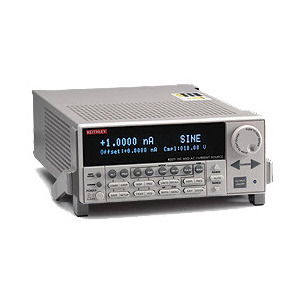
- Description
- Attributes
AC/DC Current Source with 2182A 2-Kanal Nanovoltmeter. The Model 6221 is presently the only available AC current source at the market with accordingly high resolution and the only commercially available current source signal generator which simplifies the production of complex signal forms clearly. With it signals with pulse widths can be programmed by only 5 us and the instrument supports besides pulsed I -V -measurements. The model 6221 offers towards itself to created solutions a higher accuracy, repeatability, reliability, and besides is more robust and cost-effective. The Model 6221 AC and DC Current Source combine ease of use with exceptionally low current noise. Low current sourcing is critical to applications in test environments ranging from R&D to production, especially in the semiconductor, nanotechnology, and superconductor industries. High sourcing accuracy and built-in control functions make the Model 6221 ideal for applications like hall measurements, resistance measurements using delta mode, pulsed measurements, and differential conductance measurements. It is full operating and programmable via frontpanel or via external Controller via RS-232 or GPIB interface and has a ethernet interface for remote control via ethernet connection. The instrument can generate DC currents from 100 fA to 100 mA and AC currents from 2 pA to 100 mA. It contains tools for programming from current signal courses and for gradually drive through sequences with up to 64,000 predefined output values by means of a trigger or a timer. It supports linear, logarithmic, and customised signal courses. By the combination a high resolution source with a update rate in MHZ-range can display the Model 6221 current signals with high quality, allow to hardly make a distinction itself from analog current signals. In the smallest current range from 100 fA to 100 mA it has a resolution from 100 fA and only a disturbance level from 80 fA rms and can generate AC currents from 2 pA to 100 mA with a output-update-rate from 10 MHz. The Instrument contains bulit-in generators for standard signals and arbitrary signals in a frequency range from 1 mHz to 100 kHz. A reconfigurable triax output simplifies maching the guarding requirements for applications. Software for control the instrument is for Macintosh, as well as for PC computer available. Source and sink (programmable load) 100 fA to 100 mA 1014 Ω output impedance ensures stable current sourcing into variable loads 65000-point source memory allows executing comprehensive test current sweeps directly from the current source Built-in RS-232, GPIB, Trigger Link, and digital I/O interfaces Reconfigurable triax output simplifies matching the application's guarding requirements Model 220 emulation mode eliminates need to reprogram existing applications Source AC currents from 2 pA to 100 mA for AC characterization of components and materials The 6221's 10 MHz output update rate generates smooth sine waves up to 100 kHz Built-in standard and arbitrary waveform generators with 1 mHz to 100 kHz frequency range Applications include use as a complex programmable load or sensor signal and for noise emulation Programmable pulse widths as short as 5 us, limiting power dissipation in delicate components Supports pulsed I-V measurements down to 50 us when used with Model 2182A Nanovoltmeter Built-in Ethernet interface for easy remote control without a GPIB controller card 2182A: The Keithley 2182A is a two-channel Nanovoltmeter and is optimized for making stable, low noise voltage measurements and for characterizing low resistance materials and devices reliably and repeatably. It is a powerful digital Voltmeter and offers higher measurement speed and significantly better noise performance for voltage meters than alternative low voltage measurement solutions. Low noise measurements at high speeds: Typ. 15 nV p-p at 1s response time, 40-50 nV p-p at 60 ms Delta mode: Coordinates measurements with a reversing current source at up to 24 Hz with 30 nV p-p noise (typ.) for one reading Averages multiple readings for greater noise reduction Synchronization to line: Provides 110 dB NMRR and minimizes the effect of AC common-mode currents Dual channels: For measuring voltage, temperature, or the ratio of an unknown resistance to a reference resistor Built-in thermocouple (J, K, N, T, E, R, S, and B) linearization and cold junction compensation
